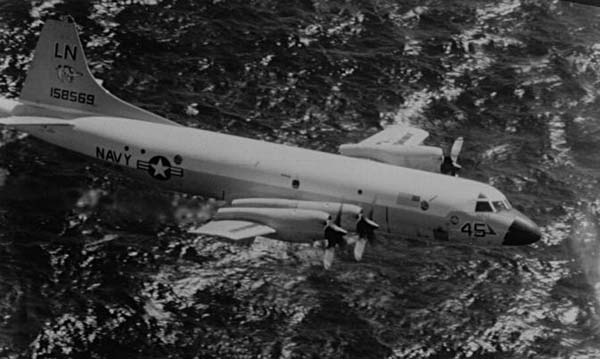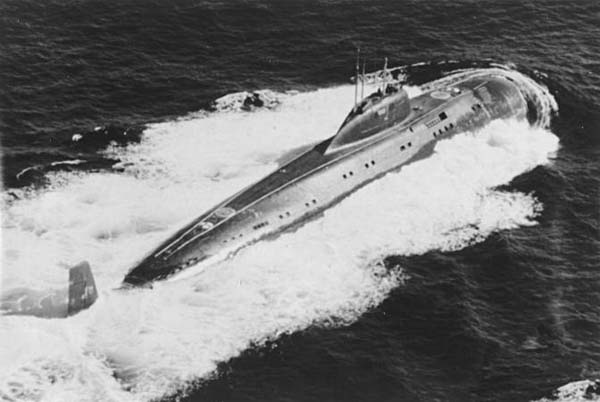
|
Lockheed P-3C Anti-Submarine Aircraft |
|
In the last issue of The Boßecker Newsletter, I wrote about Naval Aviator Raymond
Schmidt’s airplane accident in 1937. Writing that story caused me to reflect on my own
experiences as a Naval Aviator and how things have changed in the relatively short time since I
left the Navy in 1986. 15 years ago, in the Fall of 1984, I was a Lieutenant in Patrol Squadron 45 (VP-45). Patrol Squadron 45’s home port was Naval Air Station Jacksonville, FL (NAS Jacksonville). In the early 80’s, the primary mission of Patrol Squadron 45 was locating and tracking Soviet submarines. The aircraft used to accomplish that task was the Lockheed P-3 Orion. The P-3 Orion had its beginnings as a civilian airliner, the Lockheed Electra, in the late 50’s. The Electra’s 4 turbo-prop powerplants were viewed by some as a less risky transition from the propeller age to the jet age. However a series of accidents caused a re-engineering of the Electra. By the time the aircraft’s problems had been solved, the airlines had made the transition to jet powered aircraft like the Boeing 707 or DC-8 and they never looked back. At the same time the Electra had fallen out of favor with the airlines, the United States Navy was looking for a new aircraft to counter the growing Soviet submarine threat. Lockheed’s proposal was a modified Electra, the P-3. The P-3 soon became the premier Anti-Submarine Warfare (ASW) aircraft in the world. For a while it held the world speed record for propeller driven aircraft. The P-3 has the ability to search for, locate and destroy submarines. The primary anti-submarine weapon are torpedoes although depth bombs are also an option. In addition to its ASW mission, the P-3 can also be called upon to perform maritime surveillance, locate & destroy surface shipping using missiles and bombs and deliver a variety of anti-ship & anti-submarine mines. The P-3 has been modified several times since its introduction in the early 1960’s. It continues to be used today as and it is still the most advanced ASW aircraft in the world. One of the attributes that made the P-3 such an effective submarine hunter was its endurance. Although the P-3 was advertised to be able to stay aloft for 18 hours, a normal mission lasted 10 to 14 hours. In the 1980’s the main combatant of the Soviet navy was the submarine. During the Cold War the United States spent billions of dollars to counter this threat. The US Navy generally plans for its ships to go to sea, or deploy, for a period of 6 to 9 months and then return to their home port. Although Patrol Squadrons were land based, they followed this same pattern. In the fall of 1984 Patrol Squadron 45 was deployed to Rota, Spain and Lajes, The Azores. Rota is located near the mouth of the Mediterranean and Lajes is located about 800 miles west of Spain in the Atlantic Ocean. Once again our mission was to keep tabs on the Soviet Navy’s surface combatants as well as locate and track Soviet submarines. I always enjoyed patrolling over the Mediterranean more than the Atlantic patrols. The Atlantic missions almost always involved tracking Soviet ballistic missile submarines. Ballistic missile submarines carry nuclear-tipped missiles that were targeted to destroy United States cities and military installations. While tracking these submarines was of utmost importance to United States defense, it wasn’t as interesting to me as the kind of mission we did over the Mediterranean. In the 1980’s the Mediterranean Sea represented the boundary between the West, the Soviet block and Middle Eastern sponsored terrorism. The occasional Arab-Israeli spat only added to the potential for an exciting mission. Due to the instability of the region, the United States usually had an aircraft carrier battle group in the Mediterranean. The Soviets always had several hunter-killer submarines stalking the battle group. Much of a submarine’s tactical advantage is stealth. A submarine’s tactics rely on its ability to approach a target unseen, attack and slip away without detection. The goal of a P-3 crew was to locate, track and, if need be, destroy an enemy submarine before it could place itself in a position that would pose a threat to United States surface combatants. This game of "Cowboys & Indians" between a Soviet hunter-killer submarine and a P-3 was played over and over again during my 3 years patrolling the Atlantic Ocean and Mediterranean Sea. The obvious question is, "How does one find an adversary that you can’t see?" The P-3 used a variety of sensors but the primary method we used to locate a nuclear submarine was tracking the sounds it made. Each kind of Soviet submarine had its own noise "signature". Quite a bit of my training consisted of learning the various signatures that Soviet submarines produced. A P-3 would drop a number of sonobouys in the water to listen for submarines. A sonobouy would float in the water, lower a hydrophone to a specified depth and radio the noises directly to the crew of the aircraft. Highly trained crewmembers would evaluate all of the noise sent to the aircraft and pick out the noises specific to a particular submarine. With all of the above in mind, one of the major problems for Soviet submarines was getting into the Mediterranean undetected. The Soviets had one of two very narrow entry points available to them; the Strait of Gibraltar is the western entry point from the Atlantic Ocean and Bosphorus Strait is the entry point to the east from the Black Sea. Given the geographical constraints noted above, the preferred tactic for tracking Soviet submarines in the Mediterranean was to maintain a listening watch at these entry points and then follow the submarine after it entered. This is not as easy as it might appear. The Mediterranean has some of the busiest shipping lanes in the world. Surface ships make a lot of noise and they go through the same narrow passages that the submarines do as they enter & leave the Mediterranean. Of course the Soviet submarine commander was very familiar with both the noises produced by his boat and the various noises produced by surface shipping. One possible tactic that he might employ to enter the Mediterranean undetected was to attempt to sail in underneath a merchant ship. One morning, while deployed to Rota, Spain, my crew was unexpectedly called out for a patrol. While the rest of my crew prepared the aircraft for the 10 hour flight to come, another officer and myself received a briefing. The briefing was given in a special building called an ASWOC (Anti-Submarine Warfare Operational Center). The personnel in the ASWOC kept track of the comings and goings of Soviet submarines and coordinated our missions with other NATO countries so that a P-3 flying a mission from Rota, Spain wouldn’t run into another aircraft, say a British Nimrod ASW aircraft. The briefing officer told us to fly our aircraft to a specific location, drop a number of sonobouys in the water and listen for a Soviet submarine. We went to our aircraft, briefed the rest of the crew, flew to the designated position, dropped our sonobouys and waited... and waited... and waited. |

|
Soviet Victor Class Nuclear Submarine Modern submarines are very "clean" and slide through the water with very little drag. The amount of white water streaming from the bow of this submarine gives some idea of the large amount of unseen damage to the "nose" caused by the collision. |
|
Several hours passed. It was late afternoon and we were nearing the end of our patrol. It was
a clear, sunny day and many surface ships were visible. Off in the distance, coming towards us,
I noticed one that looked like a submarine. "That’s impossible", I thought, "No Soviet nuclear
submarine would be cruising on the surface of the Mediterranean." About that time my co-pilot said, "Gee, that looks like a submarine". "Yeah", I said, "it sure does". As I said this, I reduced the power to the aircraft engines and started a descent toward this oddity. As we got lower and closer it couldn’t be denied. It was a submarine all right, but what was it doing on the surface? After some discussion, we decided that it must have had some sort of problem that made subsurface travel dangerous or impossible. When we returned to Rota, Spain we were told that this submarine had tried to sneak into the Mediterranean under a Soviet merchant ship. During this maneuver, the submarine had run into the bottom of the ship which caused serious damage to both vessels. Later that week I saw a new photograph of the damaged submarine. A Soviet repair crew had filled the ballast tanks in the rear of the submarine so that the nose was clear of the water. The damage was amazing. I am sure that members of the submarine crew had been badly injured if not killed in the collision. I asked the Photographers Mate that was showing me the photograph if I could have a copy. "Oh, no sir", he replied, "this photograph is classified"! Well, that seemed reasonable... until about a month later when I saw the same exact photo on the cover of Jane’s Defense Weekly magazine. 15 years after this incident the Soviet Union no longer exists and the United States Navy no longer faces a tactical submarine threat of any significance. MORE VETERANS Here are more Boßecker descendant veterans that have been documented since the last issue. Johann Karl Stedtfeld [1896-1939] WWI Great-Grandson of Johannes Boßecker. William Charles Boseker [Born:1939] Ssgt, United States Air Force, 1963-1971 GG-Grandson of Johannes Boßecker David Henry Bosecker [Born:1945] United States Army, Viet Nam War GG-Grandson of Karl Boßecker. NEW ARRIVALS! Sophia Marie La Porta, GGGG-Granddaughter of Johannes Boßecker, was born on 29 Jun 1998. Cameron Chad Peck, GGGGG-Grandson of Johannes Boßecker, was born on 15 Dec 1998. Aurora Elizabeth Henry, GGGG-Granddaughter of Johannes Boßecker, was born on 13 Feb 1999. Evan Michael Witte, GGGG-Grandson of Johannes Boßecker and also a GGGG-Grandson of Karl Boßecker, was born on 14 Feb 1999. Brandon Michael Bosecker, GGGG-Grandson of Karl Boßecker was born on 5 Apr 1999. Lauryn Nicole Wright, GGGG-Granddaughter of Karl Boßecker was born on 5 Nov 1999. Cassidy Anne Voges, GGGGG-Granddaughter of Johannes Boßecker was born on 3 Dec 1999. Paige Emilee Hocking, GGGG-Granddaughter of Karl Boßecker was born on 22 Feb 2000. MARRIAGES! Joshua John Goddard, GGGG-Grandson of Johannes Boßecker, and Kathlee Jene King were married on 18 Apr 1998. Lori Lyn (Goddard) Marks, GGGG-Granddaughter of Johannes Boßecker, and Lex Maughan were married on 7 Aug 1998. Barry L. Bosecker, GGG-Grandson of Karl Boßecker, and Cynthia Mae Wright were married on 31 Jul 1999. IN MEMORY OF...
Albert Andrew Kleinschmidt
Melvin Henry Van Deen PUBLISHER’ NOTE
It has been almost a year since I last published an edition of The Boßecker Newsletter.
I do have an explanation. |